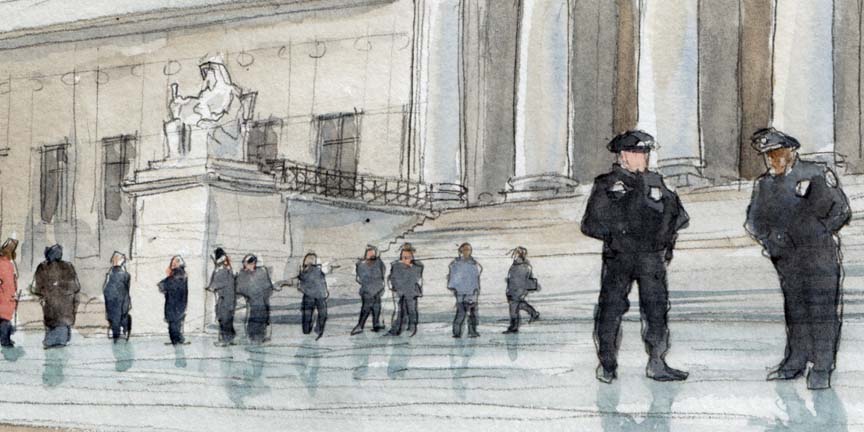Argument analysis: “A strange statute that was written in a strange way”


In the second oral argument of the new term, the justices did not seem to display any of the fractiousness that can sometimes characterize the court’s more high-profile cases. An observer who had nothing to go on except the back-and-forth in Mount Lemmon Fire District v. Guido would probably find it difficult to sort the justices according to their judicial philosophies or liberal or conservative leanings.
The question in Mount Lemmon is whether the Age Discrimination in Employment Act applies to state and local employers with fewer than 20 employees. That statute defines “employer” as:
a person engaged in an industry affecting commerce who has twenty or more employees for each working day in each of twenty or more calendar weeks in the current or preceding calendar year. … The term also means (1) any agent of such a person, and (2) a State or political subdivision of a State and any agency or instrumentality of a State or a political subdivision of a State, and any interstate agency, but such term does not include the United States.
The statute defines “person” as “one or more individuals, partnerships, associations, labor organizations, corporations, business trusts, legal representatives, or any organized groups of persons.”
E. Joshua Rosenkranz, representing the fire district, was first to argue. He had an uphill climb trying to convince the court that the answer to this statutory puzzle lies in first reading the definition of “person” to include governments, so that the first part of the definition of “employer” (which includes the 20-employee threshold) applies to states and localities. Then, the subsequent two clauses, which are offset by the words “also means,” should be read as clarifying that definition by emphasizing that the statute also covers agents and public employers. In contrast, Jeffrey Fisher, representing two former employees of the fire district, and Jonathan Bond, arguing for the U.S. solicitor general, argued that “also means” is used in both everyday conversation and the U.S. Code to “add[] something that wasn’t there before,” as Fisher put it. They reasoned that this plain-language meaning should control.
Justice Sonia Sotomayor questioned whether Rosenkranz’s reading of “person” made sense, suggesting that the statutory definition seemed to be aimed at private entities; Chief Justice John Roberts added he didn’t think of himself as a member of the organization of Bethesda, Maryland. Rosenkranz responded that the Supreme Court had previously stated that “corporations” includes municipal corporations. Further, Rosenkranz argued that the statute’s evolution supported his reading: Originally, the definition of employer excluded all government employers rather than just the United States; when Congress decided to end the exemption for state and local governments, it “just took part of the exclusion and moved it to the other side of … the ‘also means’ sentence.” Later, Fisher countered that the ADEA was amended at the same time as the Fair Labor Standards Act, and the latter amendment was “indisputably to cover political subdivisions regardless of size.”
Rosenkranz then argued that reading “also means” to add new categories to the definition of employer – a definition that Justice Neil Gorsuch called “the normal meaning” – would yield absurd results. Among those results, Rosenkranz argued, would be the imposition of ADEA liability on individual employees who qualified as “agents” of employers. Fisher disputed that this was a necessary result of his reading, though he urged the court to leave the question for another day. Perhaps troublingly for Rosenkranz, Roberts later commented that in any case, he wasn’t “sure what’s so bad about direct agent liability” – a suggestion that Bond buttressed, pointing out that other employment statutes impose individual liability.
If the ADEA covers small state and local employers, then it is more inclusive than Title VII in that regard. Justice Samuel Alito asked Fisher whether this result would be “plausible,” particularly considering that the relevant provisions of the ADEA and Title VII were enacted within two years of each other. Fisher’s answer relied on the separate drafting histories of the statutes – the ADEA was modeled on the Fair Labor Standards Act rather than Title VII – as well as their different purposes: The ADEA “was not [enacted] to stamp out animus-based discrimination like under Title VII but to achieve full employment.”
Another question taken up by several justices over the course of the argument was whether and how the statute would reach employers who attempted to avoid potential ADEA liability by creating a series of subsidiaries, each with fewer than 20 employees. Rosenkranz, Fisher and Bond all argued that their respective readings would prevent this sort of gamesmanship. Fisher and Bond argued that the “agent” clause would get at the hypothetical subsidiaries as well as true independent contractors under their reading, because covered agents would not be subject to the 20-employee threshold – though this reading might come at the cost of subjecting individual employees to liability, as Alito pointed out. On rebuttal, Rosenkranz stated that the 20-employee threshold did not apply to the agent clause under his reading either.
Apparently recognizing that his reading was not the most natural one, Rosenkranz blamed the statue’s drafter: “I am attributing rationality to someone who was obviously not doing his job very well.” Later, he added that “[t]his is a strange statute that was written in a strange way.” However, it is not clear that the justices were convinced that the statute was so strange after all: An outcome that relies on a plain-language reading of “also means” to decide the case in the employees’ favor seems likely.
Posted in Merits Cases
Cases: Mount Lemmon Fire District v. Guido